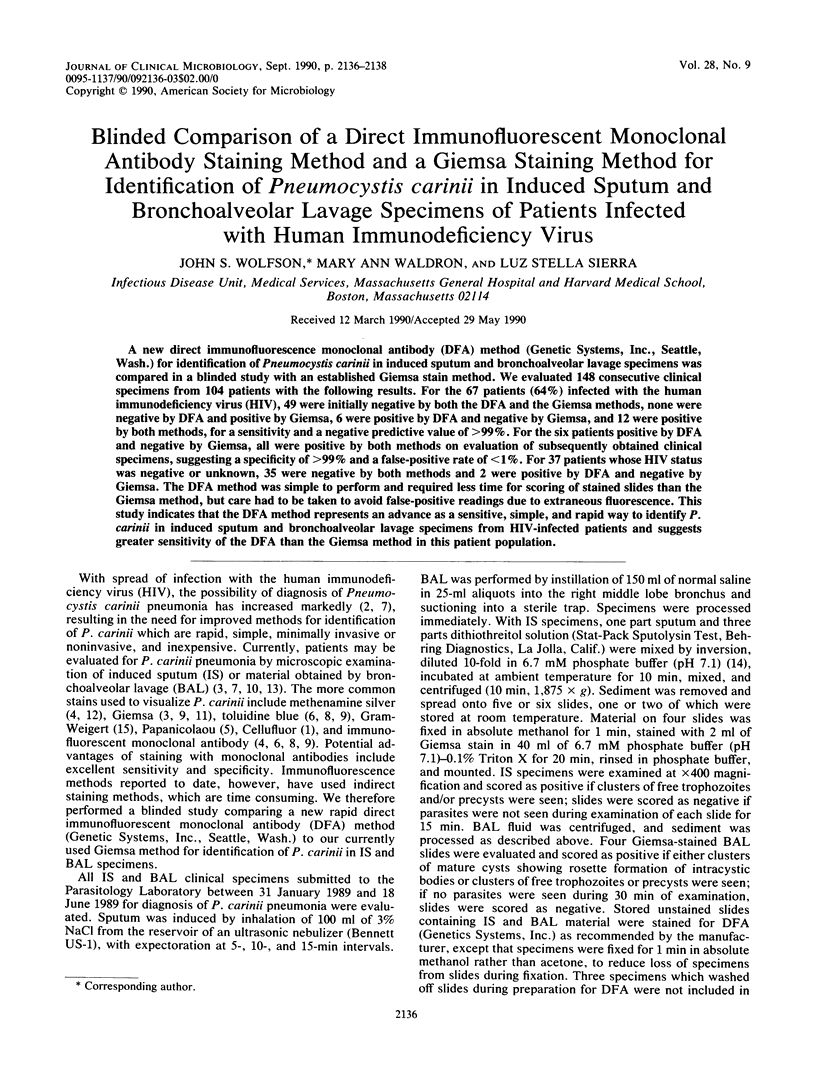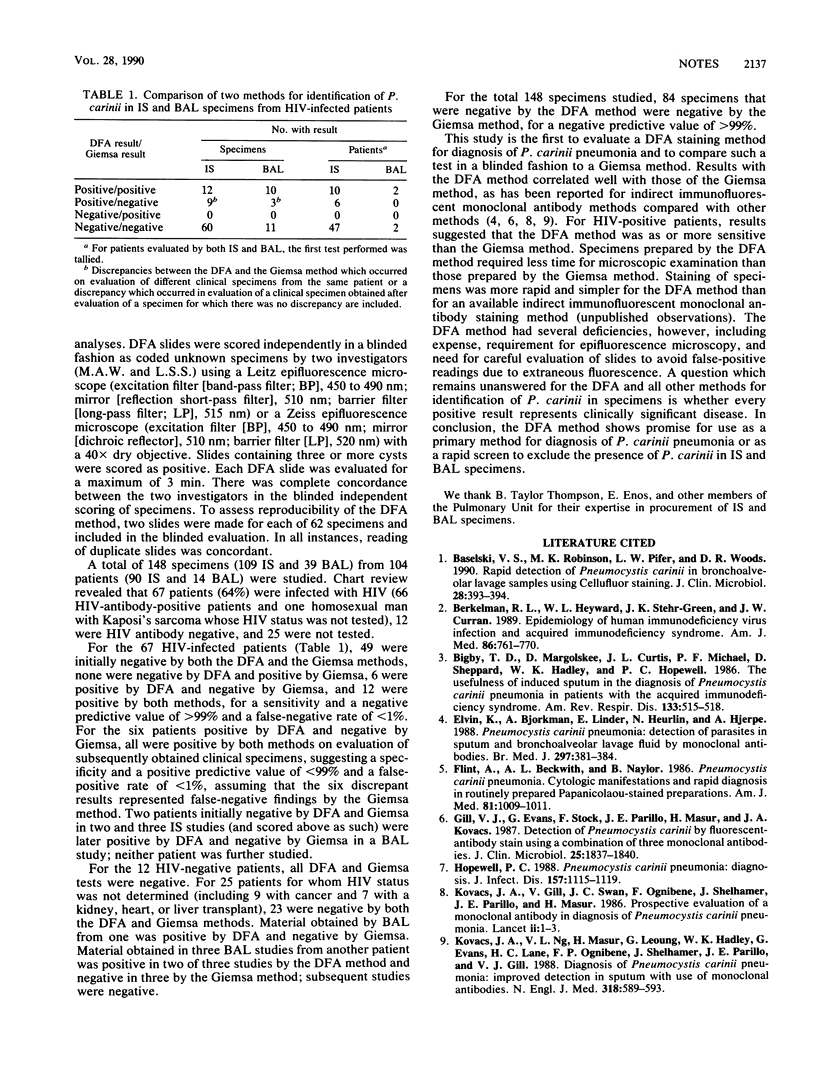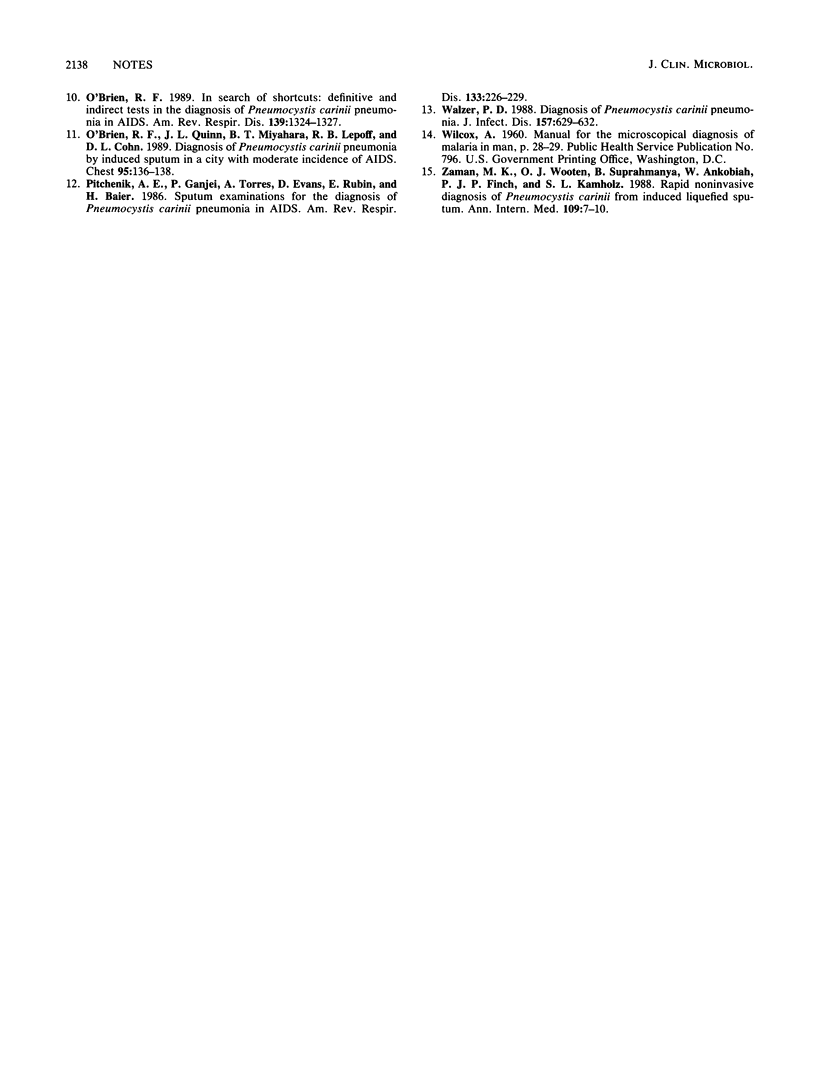Abstract
A new direct immunofluorescence monoclonal antibody (DFA) method (Genetic Systems, Inc., Seattle, Wash.) for identification of Pneumocystis carinii in induced sputum and bronchoalveolar lavage specimens was compared in a blinded study with an established Giemsa stain method. We evaluated 148 consecutive clinical specimens from 104 patients with the following results. For the 67 patients (64%) infected with the human immunodeficiency virus (HIV), 49 were initially negative by both the DFA and the Giemsa methods, none were negative by DFA and positive by Giemsa, 6 were positive by DFA and negative by Giemsa, and 12 were positive by both methods, for a sensitivity and a negative predictive value of greater than 99%. For the six patients positive by DFA and negative by Giemsa, all were positive by both methods on evaluation of subsequently obtained clinical specimens, suggesting a specificity of greater than 99% and a false-positive rate of less than 1%. For 37 patients whose HIV status was negative or unknown, 35 were negative by both methods and 2 were positive by DFA and negative by Giemsa. The DFA method was simple to perform and required less time for scoring of stained slides than the Giemsa method, but care had to be taken to avoid false-positive readings due to extraneous fluorescence. This study indicates that the DFA method represents an advance as a sensitive, simple, and rapid way to identify P. carinii in induced sputum and bronchoalveolar lavage specimens from HIV-infected patients and suggests greater sensitivity of the DFA than the Giemsa method in this patient population.
Full text
PDF


Selected References
These references are in PubMed. This may not be the complete list of references from this article.
- Baselski V. S., Robison M. K., Pifer L. W., Woods D. R. Rapid detection of Pneumocystis carinii in bronchoalveolar lavage samples by using Cellufluor staining. J Clin Microbiol. 1990 Feb;28(2):393–394. doi: 10.1128/jcm.28.2.393-394.1990. [DOI] [PMC free article] [PubMed] [Google Scholar]
- Berkelman R. L., Heyward W. L., Stehr-Green J. K., Curran J. W. Epidemiology of human immunodeficiency virus infection and acquired immunodeficiency syndrome. Am J Med. 1989 Jun;86(6 Pt 2):761–770. doi: 10.1016/0002-9343(89)90470-1. [DOI] [PubMed] [Google Scholar]
- Bigby T. D., Margolskee D., Curtis J. L., Michael P. F., Sheppard D., Hadley W. K., Hopewell P. C. The usefulness of induced sputum in the diagnosis of Pneumocystis carinii pneumonia in patients with the acquired immunodeficiency syndrome. Am Rev Respir Dis. 1986 Apr;133(4):515–518. doi: 10.1164/arrd.1986.133.4.515. [DOI] [PubMed] [Google Scholar]
- Elvin K. M., Björkman A., Linder E., Heurlin N., Hjerpe A. Pneumocystis carinii pneumonia: detection of parasites in sputum and bronchoalveolar lavage fluid by monoclonal antibodies. BMJ. 1988 Aug 6;297(6645):381–384. doi: 10.1136/bmj.297.6645.381. [DOI] [PMC free article] [PubMed] [Google Scholar]
- Flint A., Beckwith A. L., Naylor B. Pneumocystis carinii pneumonia. Cytologic manifestations and rapid diagnosis in routinely prepared Papanicolaou-stained preparations. Am J Med. 1986 Dec;81(6):1009–1011. doi: 10.1016/0002-9343(86)90397-9. [DOI] [PubMed] [Google Scholar]
- Gill V. J., Evans G., Stock F., Parrillo J. E., Masur H., Kovacs J. A. Detection of Pneumocystis carinii by fluorescent-antibody stain using a combination of three monoclonal antibodies. J Clin Microbiol. 1987 Oct;25(10):1837–1840. doi: 10.1128/jcm.25.10.1837-1840.1987. [DOI] [PMC free article] [PubMed] [Google Scholar]
- Hopewell P. C. Pneumocystis carinii pneumonia: diagnosis. J Infect Dis. 1988 Jun;157(6):1115–1119. doi: 10.1093/infdis/157.6.1115. [DOI] [PubMed] [Google Scholar]
- Kovacs J. A., Gill V., Swan J. C., Ognibene F., Shelhamer J., Parrillo J. E., Masur H. Prospective evaluation of a monoclonal antibody in diagnosis of Pneumocystis carinii pneumonia. Lancet. 1986 Jul 5;2(8497):1–3. doi: 10.1016/s0140-6736(86)92555-9. [DOI] [PubMed] [Google Scholar]
- Kovacs J. A., Ng V. L., Masur H., Leoung G., Hadley W. K., Evans G., Lane H. C., Ognibene F. P., Shelhamer J., Parrillo J. E. Diagnosis of Pneumocystis carinii pneumonia: improved detection in sputum with use of monoclonal antibodies. N Engl J Med. 1988 Mar 10;318(10):589–593. doi: 10.1056/NEJM198803103181001. [DOI] [PubMed] [Google Scholar]
- O'Brien R. F. In search of shortcuts: definitive and indirect tests in the diagnosis of Pneumocystis carinii pneumonia in AIDS. Am Rev Respir Dis. 1989 Jun;139(6):1324–1327. doi: 10.1164/ajrccm/139.6.1324. [DOI] [PubMed] [Google Scholar]
- O'Brien R. F., Quinn J. L., Miyahara B. T., Lepoff R. B., Cohn D. L. Diagnosis of Pneumocystis carinii pneumonia by induced sputum in a city with moderate incidence of AIDS. Chest. 1989 Jan;95(1):136–138. doi: 10.1378/chest.95.1.136. [DOI] [PubMed] [Google Scholar]
- Pitchenik A. E., Ganjei P., Torres A., Evans D. A., Rubin E., Baier H. Sputum examination for the diagnosis of Pneumocystis carinii pneumonia in the acquired immunodeficiency syndrome. Am Rev Respir Dis. 1986 Feb;133(2):226–229. doi: 10.1164/arrd.1986.133.2.226. [DOI] [PubMed] [Google Scholar]
- Walzer P. D. Diagnosis of Pneumocystis carinii pneumonia. J Infect Dis. 1988 Apr;157(4):629–632. doi: 10.1093/infdis/157.4.629. [DOI] [PubMed] [Google Scholar]
- Zaman M. K., Wooten O. J., Suprahmanya B., Ankobiah W., Finch P. J., Kamholz S. L. Rapid noninvasive diagnosis of Pneumocystis carinii from induced liquefied sputum. Ann Intern Med. 1988 Jul 1;109(1):7–10. doi: 10.7326/0003-4819-109-1-7. [DOI] [PubMed] [Google Scholar]


